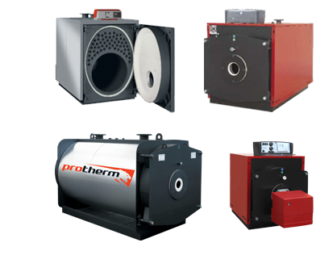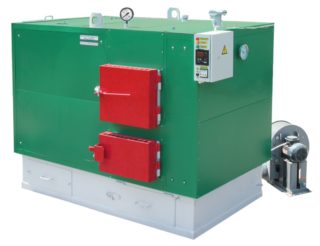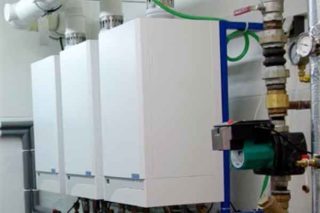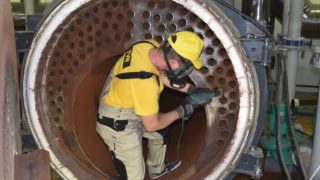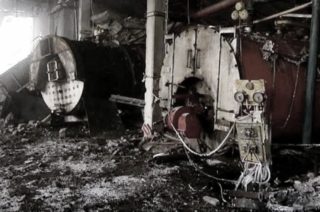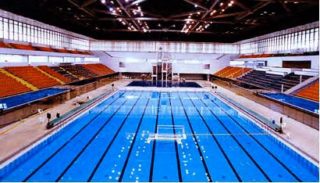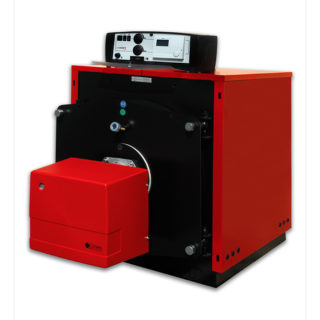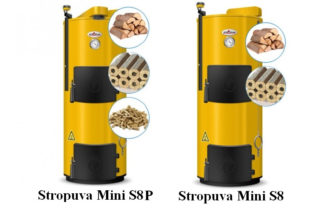A domestic hot water boiler is a device designed to heat residential and utility rooms through the use of thermal energy released during the combustion of fuel. The coolant can be used both in a closed circuit and in a flow mode for domestic purposes. The scope of devices is unusually wide. Modern devices are compact, safe and highly efficient.
The device of the boiler
The basic arrangement of heating devices is approximately the same and may differ in such indicators as fuel consumption, power, size and country of manufacture.
A standard heating boiler consists of the following parts:
- steel case;
- burner;
- wick;
- inlet pipes (located below);
- outlet pipes (located on top of the housing);
- steam valve;
- the combustion chamber;
- water heat exchangers;
- firebox with door;
- blown with a handle;
- chimney with gate valve and protective cap.
The furnace of solid fuel boilers is equipped with grates designed to accommodate fuel and discharge to the ash pan of waste products (slag, ash, ash).
The principle of operation of water heating boilers is as follows:
- loading fuel into the furnace and setting it on fire (connecting an electric heater);
- filling the circuit and heat exchanger with water;
- the liquid heats up, by gravity moves through the pipes by gravity;
- combustion products are discharged through a conventional or coaxial chimney;
- the valve controls the air supply necessary for burning fuel.
The boilers are made of durable heat-resistant steel that can withstand high temperatures.
Fuel Type Modifications
By the method of heating the coolant, two types of boilers are distinguished:
- Water pipe. In them, the heating of the liquid occurs in the heat exchanger under the influence of the heat of the burning fuel. Smoke is discharged into the street through an insulated chimney.
- Gas pipe. It uses the energy of the gases generated during combustion. They pass through a pipe, on top of which another external pipe with liquid is installed.
Devices can be universal or work only on one fuel. Classification of boilers:
- Solid fuel. Units can be filled with coal, firewood, briquettes, plastic and rubber. They have a simple and reliable device, but they pollute the environment.
- Gas fuel. They are the best option in terms of environmental friendliness and profitability. Differ in high reliability and safety. A gas water boiler is an excellent choice if you can connect to an industrial highway.
- Fuel oil. They operate on diesel fuel, but can also burn other liquid hydrocarbons. According to the principle of action, they are similar to gas analogues, but emit toxic smoke.
- Electric. They are the cleanest in terms of ecology, since by-products are completely absent. The downside is that energy is expensive and heating costs can be prohibitive.
The choice of the boiler is based on an analysis of the market and the cost of fuel. Priority should be given to economical options and universal designs.
Classification by type of accommodation
Water heating devices, depending on power and design, have different weights and sizes. In many ways, this determines the place where they are allowed to be installed.
Floor products are characterized by significant weight and dimensions. It is impossible to suspend them precisely because of these factors, since not every bearing surface can withstand such a load. The plus is that such devices are more reliable and functional.
Wall-mounted boilers are compact and lightweight. Their development was originally aimed at ensuring that the products could be installed in cramped spaces - a kitchen, a bathroom, a cellar. Due to size restrictions, such boilers are not designed for high power, the tightness of the location of parts makes their maintenance difficult and reduces the level of reliability.
Specifications
The main technical characteristics of hot water equipment are as follows:
- device - fire tube, water tube;
- working temperature - low temperature (up to + 115 ºС), high temperature (+ 115-200 ºС);
- coolant - water;
- functionality - single-circuit (only heating), double-circuit (heating, hot water);
- nominal pressure in the system - 0.6-0.8 MPa;
- power output - 3-28 kW;
- types of fuel - firewood, briquettes, gas, diesel, mining, fuel oil, electricity;
- management - manual, automatic.
The selection of the product is based on its purpose, size and configuration of the object in which it will be installed.
Terms of Use
The life of the boiler depends on the quality of its manufacture, the solutions used in the assembly and compliance with the operating standards. Installation of the device must be done in strict accordance with the technical description of the product and the drawing.
Using the device requires compliance with the following rules:
- use only those types of fuel that are listed in the instructions for the device;
- when using solid fuel devices, have tanks for pouring recoverable ash;
- the door of the furnace must be constantly closed;
- ensure that the temperature and pressure set by the regulation are maintained in the circuit;
- the room where the boiler is located must be protected from access by strangers;
- Manometers and thermometers should be checked at least once every 12 months;
- safety valves must be checked and purged before each start-up of the boiler;
- regular cleaning of the chimney is required, even if the stove consumes natural gas;
- Having heard the indicator signal about a system malfunction, you need to act quickly, in strict accordance with the emergency stop instructions.
To refuel the circuit, you must use water with the salinity and alkalinity standards set for the product in order to prevent the development of corrosion and the formation of plaque inside the circuit.
Application area
The scope of boilers applies to all areas of human activity. Products are used for heating residential and business facilities, covering almost all areas of industry:
Subject to safety requirements, heating equipment can be installed in such places:
- apartments, cottages, cottages, private houses;
- warehouses;
- agricultural buildings;
- buildings for keeping animals and birds;
- storage facilities for vegetables and grain;
- hangars and closed pavilions;
- mines, drilling rigs, artels and villages located outside populated areas;
- tourist camps and holiday homes.
When choosing a boiler, it is recommended to pay attention to the origin of the goods. Priority should be given to trusted manufacturers with a worldwide reputation.
Brands and models of the boiler
The leading positions are occupied by such models of gas equipment:
- Wolf GKS Eurotwin;
- Buderus Logano G334WS;
- Vaillant atmoCRAFT VK INT 1454/9;
In addition, it is worth paying attention to such brands:
- Ballu;
- Timberk;
- Kovea;
- Ranger;
- Siabs;
- Viessmann;
- Ariston;
- Protherm;
- Ferroli
- Immergas;
- Baxi;
- ATEM.
From solid fuel boilers, the following products are most popular:
- Stropuva Mini S8;
- ZOTA Poplar-22VK;
- ZOTA Poplar-16VK;
- ZOTA Poplar-32VK;
- Stropuva S30;
- Stropuva S40;
- TEPLOV Universal TA-40;
- SAS UWT 14;
- TRIAN TPG-15.
For those who decide to use electricity as an energy source, it is recommended to opt for such products:
- Zota
- Rusnit;
- Evan
- Buderus;
- Proterm.
The choice of goods depends on the conditions of its forthcoming operation, the generated capacity, dimensions and own financial capabilities. Water-heating devices are purchased for decades, it is better not to save here.
